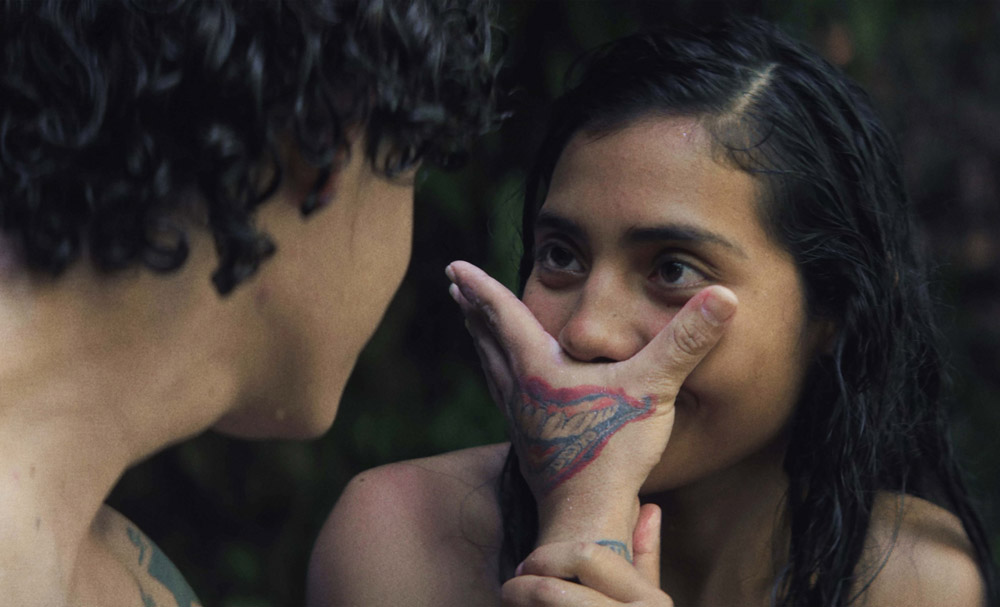Justin Lerner recently found himself walking back onto the campus of UCLA where he was once a film student and having directed three features already, there might be an extra strength in his stride, having beaten the odds that so many of his classmates have run up against in building sustainable careers in the industry, but this was no victory lap around Westwood for himself alone, excited for the opportunity to present not only a new film “Cadejo Blanco” at his alma mater, but one that he made with students of his own.
“I’m super proud, not only as a filmmaker, but as a teacher that one of my students Pedro Murcia has a feature film under his belt at 24 years old and [now] he’s currently studying at UCLA, getting his master’s,” says Lerner, who first connected with Murcia at the School of Film and Visual Arts at the University of Francisco Marroquin as one of the Guatemalan college’s originating educators. “He was a co-producer on the film, he was our fixer and one of our casting directors. He was our locations guy…He’s my Guatemalan Orson Welles.”
There were a number of new filmmakers who came out of “Cadejo Blanco,” and Lerner might actually include himself as one of them when the prospect of making a crime thriller in Central America appears to have rejuvenated him as a director after probing relationships with unorthodox points of connection in his two absorbing stateside dramas “Girlfriend” and “The Automatic Hate.” After spending a good deal of his youth in Spain, there wasn’t as much of an adjustment as one may think for the Boston-bred filmmaker, but nonetheless he took three separate passes over as many years at getting just the right lingo that can be heard on the streets of Puerto Barrios for the film, which follows Sarita (Karen Martínez), a young woman in search of her sister that takes her into the depths of the underworld when the last person she saw with her was her boyfriend Andrés (Rudy Rodriguez), a bartender at the local club with ties to a criminal clica.
As Sarita steels herself to be believed as someone as morally malleable as the ruffians she comes across when rising through the ranks becomes the only way to get closer to the truth, “Cadejo Blanco” taps into the cinematic verve that has long powered Lerner’s work with unbroken takes where not knowing where the camera will go next is an extension of characters who don’t necessarily know what their next move is and surely don’t let onto one another if they do. However, in Guatemala, the director works at a scale he never has before, inviting the entire community to participate in the telling of their own story from stem to stern, engaged at every level from the production to act as cast and crew, all pulled through with a magnetic lead turn from Martínez, one of the few professional actors on set, as the film’s indomitable heroine. The collective power that the filmmaker harnessed results in a taut thriller that isn’t likely to leave one’s memory any time soon, or for that matter, the talent that it introduces to the world and as the film arrives in the U.S. beginning with a Los Angeles theatrical run at the Laemmle NoHo this Friday where Lerner and crew will be joined for a Q & A by Sean Baker on opening night, the director spoke about the career-altering work and the many years he put into it, how authenticity led to a more intriguing story and the excitement of filming in a place that has largely avoided the spotlight.
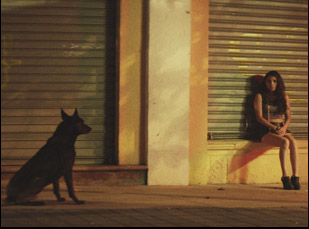
It’s a little secret undercover life. [laughs] I don’t have a secret family down there, just a secret life — my wife actually comes down with me to Guatemala sometimes when I’m there. In 2016, I got invited to help start a film school in Guatemala City and there’s a few small certificate-type programs and technical schools, but this was the first film school that was trying to model its curriculum after American and European MFA programs and undergrad film programs, so having gone to an MFA program at UCLA, they invited me to come consult and help build a curriculum and about a year later, they invited me to be the first professor of the school.
Pedro Murcia, one of my very first students in the very first class I taught, would invite me every few weekends to visit his hometown on the Caribbean coast because it’s a very different type of landscape than the urban concrete jungle that is Guatemala City. It’s much more of a tropical climate. It’s beaches, it’s rivers, it’s fishing, it’s jungle. It’s a really beautiful part of the country that you never associate with Guatemala, so I went down there and I realized no feature film had ever shot in Puerto Barrios with the exception of one scene in 1933, [when] they shot a scene from “Tarzan,” pretending that it was Africa, but the city’s untouched by film as far as features go, so as I’m spending my weekends there, doing more of the touristy stuff, I start meeting kids from the town that either are friends with Pedro or they know his family or friends of friends and during a week that I didn’t have to teach, I started realizing these young people [from] 15 to 25 were all involved either directly or tangentially in disorganized crime, meaning these cliquas or gangs, but not the way you think of it in the cliched movie version where there’s a cartel and a leader. These are groups of kids who do odd jobs for criminals, get paid, have protection because they’re doing it, so they’re loyal. Some of them go to school, some of them work another job and what struck me the most right away is that women were part of these gangs and they actually were high up, doing very detailed criminal jobs, more so than just sex work or being paid for protection.
The women in this town that I met that were part of the gangs were very different than you would expect and different from anything you’ve ever seen represented on film, so after seeing that, I just felt there’s a story here that maybe the world of cinema doesn’t have. And [I wondered], am I the right person? Because I’m not from there, I’m a foreigner, but I knew if I made a film, I’d have access to a world of cinema outside of Guatemala being that I have a track record of having films played at festivals, and I thought as long as I do the work necessary to really render a portrait of this town and the people responsibly, maybe this could be an interesting thing to offer the world that doesn’t exist yet. So little by little, I started meeting [people in the community] and asking them to be interviewed. Some didn’t want to, some did. I had special access to a lot of them and trust via Pedro [because] his father’s a criminal justice attorney in the town and he works with a lot of at-risk youth and people who are getting out of the gangs and trying to find work and go on the straight and narrow.
Over the course of three years, I started living down there part-time and meeting with these people, mostly the young, but also some older people who had been part of the gangs and a lot of police and neighbors and I put together a very long story and then the next process was presenting my script and my story to them, [so they could] tell me where I got it wrong and how they would fix it. And the people that kept coming back and kept wanting to be part of my research, I [would] say, “Would you want to audition? Maybe play yourself or not yourself, but a fictional version of yourself.” Some did, some didn’t, but over the course of another year, we had a cast of people that either had come from that world directly or their family or friends had, and they were intimately familiar with it.
While the film does have a few professional actors that we peppered in to show a lot of the talent that is in Guatemala, I’d say 80% of the cast is non-professionals working for the first time, playing versions of themselves and they were encouraged at all points to change their own dialogue, improvise and tell me any time that I was getting something wrong. The whole reason I said I’m going to do this [film] is if [they] have control over the way that they’re going to be seen and heard on film and I was more of the behind the scenes person making sure the story worked, and I think now what we have is a really nice document of their lives, fictionalized of course, slightly to be a movie, but if you went to Puerto Barrios, you would see these people on the street, you’d see them in a store and for me, it was a really rewarding experience to make a film in this way where it’s almost like an investigative journalist and a documentarian mixed in with narrative filmmaking.
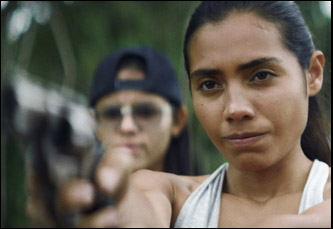
Yeah, this was all done on my free time from the school. But I cast some of the students, not only as small parts in the part that takes place in Guatemala City in the wealthier neighborhood where [Sarita’s] boyfriend lives, and I did employ many of my former students on the crew that wanted to get firsthand experience of a feature. My director’s assistant for the film was one of my other students [and some worked] in different grip, electric PA categories or departments. And I did partner with an NGO in Puerto Barrios where we shot that tries to help people who are food insecure or homeless in the town and try to keep them out of gang life and an NGO partnered with us so that we were able to get some of the money that we make back from the film into the community, as well as solidify a few scholarships and grants to send some of the kids who are still interested in learning more about film to some classes in film to continue an education in film, if they want to.
They [also] have other things going on in their lives. The movie was fun for them and it was a great [time] because they were employed for the whole shoot. Some of them, when they weren’t in scenes, we put them on the crew — we had this big nightclub scene in which Sarita has to walk into a 400-extra nightclub in a long take without cutting with everyone dancing and drinking and throwing each other in the pool, so we hired a lot of the people who played the gang to help us coordinate the extras because they knew a lot of our extras and check in and give them their meal and their bracelet and then sign the waiver. It took months for them to actually believe we’re really making a movie because it’s not something they’re used to. It was a big family and little by little, they started to really believe that we were actually making movie.
That’s really exciting. How did the location inspire you? There’s an incredible take that follows the passing of a note through a soccer game and it’s fascinating in story terms, but also get to show off the neighborhood.
Part of shooting there was to show not only the world, like the camera was a person walking around in Puerto Barrios, but [how] everything there is so beautiful and close by, so I thought long takes where a character could float from a soccer field to a taco truck stand across the street to another taqueria and see everyone in the street, that [was] my [own] experience walking through the town, so [in the film] there’s about seven or eight takes that last forever, where you’re just following a character, usually Karen Martinez, the lead actress. But in the shot you were explaining, it was the passing of a note where they’re looking for someone that “they have to take care of,” and they’re afraid of texting because they never know who could be tapping their phone. This is something that I learned in my research is that when there’s very sensitive information that needs to be passed from people, they use kids in town to pass handwritten notes sometimes, or just whisper from person to person, so when I started hearing that, I’m like, “Well, how do you get information around quickly?” [And people would tell me], “We have friends and kids that we take care of and they’re not in the gang, but they follow around the gang, so if we need [it], we have a code that we speak and notes that we pass.”
So I thought that could be a great set-piece for the movie [when] they’re trying to find someone who, in order to get into the gang, Sarita has to help them kill [and when it’s a drug lord] from a neighboring town, why not show the sequence of events of how they would locate him and pass all the information through the city, starting on the football field and all the way across the street and through a taco truck. I worked with [Roman Kasseroller] a new cinematographer I’ve never worked with before from Argentina, and we worked together on trying to make the photography a character where it’s like you float you through the town the way that we felt when we were two foreigners just walking around Puerto Barrios. So what we ended up doing is find moments where we can walk alongside Sarita and feel the town in the shots and the sound. We also worked with Frank Gaeta, an amazing sound designer who’s from Mexico who has done all of Alexander Payne’s movies, “The Motorcycle Diaries” and “Hell or High Water” and we recorded all these sounds from the neighborhood that you would never get anywhere else to make you like an immersive experience. But the goal with the long takes to was show that I’m not manipulating a performance by these non-actors and allow them to be themselves without cutting. This took much more rehearsal and a lot of practice, but getting the kids that are first-time non-professional actors to just be themselves and then capture it — sometimes you’re only going to get something great once or twice, so let’s cut as little as possible so that if they do happen to get something great, let’s just put it in the movie.
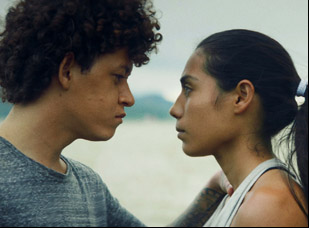
Yeah, always. First of all, having this many actors in a movie in a foreign language, I could use all the help I could get to help the people who were non-actors train and Brandon Lopez, who plays Damian, the highest ranking “boss,” which worked because he was the only professional actor in the gang if you don’t count Karen, who joins it during the movie, and he was the only one from Guatemala City and had to pretend he was from Puerto Barrios, so he worked on his accent. But all those kids had seen him in a really great film from 2013 called “La Jaula de Oro” – “The Golden Dream” – which premiered at Cannes Un Certain Regard in 2013, and he won an Ariel Award, which is Mexico’s version of the Oscars, so even though they weren’t really film savvy, that film played everywhere in Latin America and they recognized him, so they did have a certain respect for Brandon. Brandon also lives in zone three in Guatemala City, which he will tell you has its share of characters from this world and he has experienced on the periphery, not inside, the crime world, so he had that comfort with them as well and he was instrumental to me in getting those [acting] exercises in the morning – being in front of the camera, running lines, making sure they knew that they could improvise, getting them excited about the day and letting them know how to pace themselves for a 12-hour shooting day.
And then Karen Martinez was very helpful with the first-time actress who played her younger sister. They would work for hours without me, improvising and changing the script to fit their voice better. The first line where they’re arguing and joking in their bed, I think two of my lines made it through to the final scene. We also hired an amazing acting coach who studied at Carlos Reygadas’ film school in Mexico City, and she specializes in training non-professional actors. She worked with Rudy Rodriguez, who plays Andres, for a month or two before acting sessions work. He tended bar in her bar, just to know what it was like to be a bartender. And so I had a lot of help and I couldn’t have done it without all the Guatemalan support, especially from the actors in helping me with such a big cast.
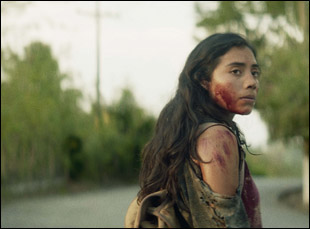
I didn’t know if I could make the film until I found someone who could play Sarita [because] you have this working class girl who has to be introverted at the beginning and then really tough by the end to make it through without dying. I had been aware of her from “La Jala de Oro,” but she had shot that seven years before when she was 16 and [now she] was 23 when we shot, but when she came into audition, I was like, “Okay, I can make the movie.” She has the subtlety of someone who knows herself on film, but does everything so small and quiet that we just wanted to put her experiencing everything at the forefront of every scene. And for months, she would come over every couple of days and we just talked through the script and I asked her, “Please, let’s make this a collaboration where you’re going to add things to the character,” and she really did.
I don’t want to speak for her because she has a really intense process, but she was instrumental in co-writing the character with me once we agreed on the basics and she brought a lot of her own experience to it – she’s very protective of her family and she lives in a working class area not too different than the area that the character lives, so she found a lot of places where there was overlap and my whole job with all of the actors was allowing them, at any point where we weren’t sure how to play something, to add their own life or thoughts into it, because a part of this movie is about a girl who goes to a small town thinking that these kids in the gang murdered her sister and she has these preconceptions and prejudices as she’s going in slowly reversed or changed. What she had thought about the life of these criminals is something completely different than what actually exists and this mirrors a lot of the experience I had going to the town for the first time, where I had my own American prejudices of what a gang was like in Latin America, only to find that it’s nothing that I thought and that culture shock gave me a huge motivation to try to show a different side of these criminal networks that are not even networks. They’re just neighborhoods and people looking for family and protection and a way to make a living.
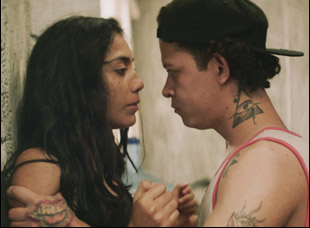
We were the opening night film at the Icaro Film Festival, which is the oldest Central America film festival in Guatemala every December chartered a bus for everyone from Puerto Barrios who wanted to come to the premiere in Guatemala City, [which is] a four or five hour drive without traffic. We came out in theaters the next year, but our first ever public screening was at the National Theater in downtown Guatemala City, which is a beautiful building and we did a red carpet and I was worried that [the cast] was going to be weirded out because for a lot of them, it was the first time they’d been to a movie theater. A lot of them watch movies just on their phones and on YouTube. But they loved it and I think they were just blown away by seeing themselves inside a functioning feature film and they really weren’t able to process their performance or their town or anything like that after that until like a second or third viewing, but that was a really rewarding experience seeing that.
The best story I have is there’s a little kid named Luli, who is one of the note passers in that [scene you mentioned] and [in the film] he plays a character also named Luli who follows the gang around and does little odd jobs for him, so I showed him the [note passing] scene because we had to do some ADR with him and he put on the headphones and as I see him watching himself on film in that scene, he started crying a little bit, not a lot. He’s kind of a proud guy. And then he takes off the headphones and he turns and he asks, “Does this mean I’m going to get a lot of girls now, now that I’m in this?” [laughs]
It was a really special experience for me, not only showing them the film, but watching them all take part in the movie making process and wanting to be there, getting sad the last couple of days when it was done. And this was the most ambitious thing I’ve tried [as a filmmaker], based on the process of doing years of research first, interviews, and then starting the script, and then casting real people to play themselves. It really changed the way I look at filmmaking and I don’t think I could go back. While I love “Girlfriend” and “The Automatic Hate,” I’m really now really interested in stories that even if they’re not real, they’re based on something true, and even the script phase, I start like a journalist and try to involve as many non-professionals as possible.
In the American moviemaking system, that’s not always going to be workable, but I do want to try to apply as much as I can of that process of letting the lines be improv by the people and not necessarily having a script until the cast is there, so it was an important experience to me. With a new project, I’m always looking for “Can I tell something that hasn’t been told yet?” And there’s plenty of films about Latin American gangs and how bad it is, but for this, I [saw] there’s never been a feature film shot in Puerto Barrios and no one really knows about these clicas and that women can join them most of the time and it was about showing the humanity in the people and seeing that it’s more morally complicated than that these people are evil. They’re part of a big socioeconomic system that doesn’t really allow them much more opportunities to protect themselves and to get money, and these kids that are playing soccer and going out on dates with girls remind me of my nieces and nephews, and had they been born in the little suburban Boston neighborhood that my nieces and nephews were born in, they might be almost indistinguishable. That’s a big reason why this film was important to me. I feel like I added something that didn’t exist yet in storytelling.
“Cadejo Blanco” will open on April 21st in Los Angeles at the Laemmle NoHo 7 and become available on VOD on July 11th.




